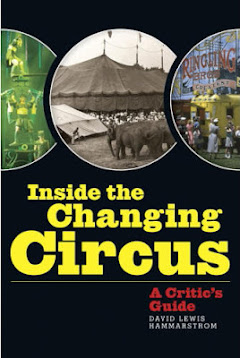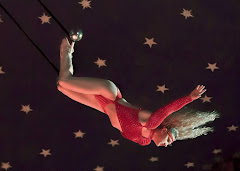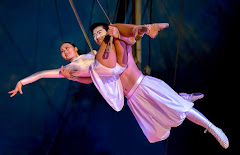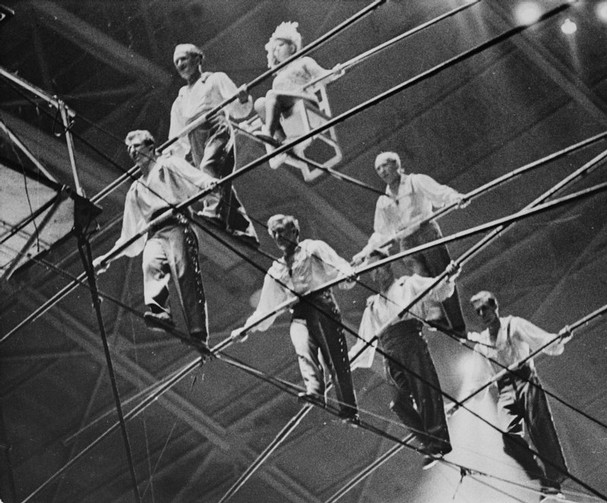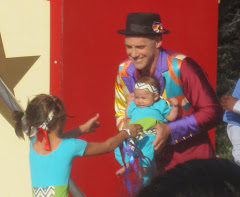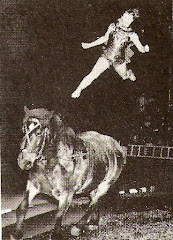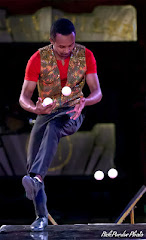
Update, 11/3 AM: Believe was panned in today's Los Angeles Times -- "unbelievably bad"
They don’t believe in Believe, no they don’t, and they are die-hard Cirque fans with passion and attitude, and how I love that ... So mad are they, they knocked their way up to the top of this week’s flip flop pile. Oh, are they courageously vocal: “SOOOOOOOOO disappointing! Criss Angel is a douche bag and Cirque is ruining their reputation by putting their name on this show!!!” cries Cirque fan “g.” G oh G, I feel your sense of abandonment, recalling when a circus called Ringling gave up its tents many years ago and I spent many days crying all alone in my bedroom ... And here rattles another shocked non-believer, fully named Matt Krogol, who sheds emotion on this here blog: “How can Cirque even put their name on such a worthless show?” Matt’s seen all the Vegas Cirque things and he’s not cheering this one: “4 clowns pre show were very good. I cannot name one good thing about the rest of the show.” Might you have overlooked, Matt, the rumored spectacle of Guy Laliberte himself dropping by and walking out early on his own show in disgust? ... To a protest Matt sent to Montreal came a cordial reply including “My apologies if offense was taken.”
Mine, too. Here’s the skinny, Cirque addicts: I’m thinking more and more that your Genius-in-Chief, Laliberte the Great, is really really hurting for money, having promised too many new shows to too many venues. Perhaps what you beheld in Believe is evidence of a shrinking kitty up in Quebecland. Which is why, go my hunches, Guy took 200 million bucks from Dubai and gave ‘em 20 percent of his (foundering?) empire. Buckle up, kids, the ride ahead could be bumpy, ugly, and very un-Cirque like ... Vegas biz overall tumbling, and that could put fewer believers in the seats. MGM reported a stunning 67% drop over the last year in revenue at the slots and tables ...
Oh, I could go on (I too, believe it or not, am a fan of Cirque at its best). But other tents on the midway deserve a peek: Let’s see, Kenneth Feld in court on possibly bogus animal abuse charges, told by the judge to go home. Seems the other side can’t get all of its animal witnesses together and on point. The saga continues in ‘09 ... Meantime, animals still lighting up rings, so bring them on ...
Here in the shrinking menagerie, a few weeks back I compared circuses no longer on the road (or hurting for patrons) that did not feature animals of any sort with circuses that do and are still somehow muddling about in the mud if not the money. Wade Burck didn’t buy it, pointing to the dearth of big cage acts, among other reasoned reasons — “Don’t you start with the spin now.... Big Apple dogs and horses – not the same thing as cats, elephants and bears.” While you’re at it, Wade, how about some respect for seals and monkeys, too? But here’s two points to keep your whip a crackin’, Mr. Cage Man: Just like the big 3 network audience splintering off into thousands of cable options, so too, why not the circus? Smaller may work for some time, especially with the next Great Depression likely upon us.
Point two: Spirit of circus comes through in a variety of acts and ways; does every show have to contain every staple? Ringling-Barnum for a spell featured tigers and/or lions only at the spring Garden dates. Charles Ringling shunned jungle theatrics. Horses were the modern-era circus's original act, and those ever-delightful doggies remind us of how wonderful can be the interactions between humans and four-legged creatures.
Talk about spirit. Big Apple Circus now uncorking at Lincoln center and drawing rosy salutes from Gotham scribes, their prose pointing to a tip-top musical delight. Play On!, I finally learn, refers to the band, and this opus bounces high and wide on a wide assortment of tunes, including a rendition of "Singing in the Rain" as the clowns splash about. Ah, does that send my Gene Kelly heart into orbit just imagining.
Where was I on this slow Halloween night at L'Amyx? Tea tenders Will and Boyi telling me of a co-worker dressing up as a tea pot. Reminds me of my boyhood in roller rinks, once showing up on Halloween night dressed as a milk carton.
 Little big top bits: Carson and Barnes into another tentless arena at Tulsa, as the last three ring fling heads for the last barn. Might the Byrds be flirting with a radical venue shift? Down the Covington chute, news about one-time Cirque performer Chris Lashua taking his theoretically deft Birdhouse Factory onto the Victory Theatre stage in New York, come November 15, for a four-week slate. When I saw it premiere for the New Pickles in San Francisco in 2005 it’s ingeniously crafted brilliance struck me as in need either of Laliberte loot and drive to blow up the circus action, or a fine playwright to give its narrative inclinations true dramatic power. Stranded cerebrally in-between the two prospects, Birdhouse came out stillborn to my eyes ... Gifted director Lashua, though, is a most inventive force to watch. So watch him! ... Farewell, two fine big toppers, passing onto the bigger lot up there: Great Baraboo born trap star who gave Ringling true center ring status, Mark David ; and Bob McDougall, who managed a unit of the Big Show for a number of years. Super nice guy, he once spoke with me after a Ringling matinee in L.A. mid 1980s, sharing the truth: some afternoon performances only drawing hundreds rather than thousands during a down period.
Little big top bits: Carson and Barnes into another tentless arena at Tulsa, as the last three ring fling heads for the last barn. Might the Byrds be flirting with a radical venue shift? Down the Covington chute, news about one-time Cirque performer Chris Lashua taking his theoretically deft Birdhouse Factory onto the Victory Theatre stage in New York, come November 15, for a four-week slate. When I saw it premiere for the New Pickles in San Francisco in 2005 it’s ingeniously crafted brilliance struck me as in need either of Laliberte loot and drive to blow up the circus action, or a fine playwright to give its narrative inclinations true dramatic power. Stranded cerebrally in-between the two prospects, Birdhouse came out stillborn to my eyes ... Gifted director Lashua, though, is a most inventive force to watch. So watch him! ... Farewell, two fine big toppers, passing onto the bigger lot up there: Great Baraboo born trap star who gave Ringling true center ring status, Mark David ; and Bob McDougall, who managed a unit of the Big Show for a number of years. Super nice guy, he once spoke with me after a Ringling matinee in L.A. mid 1980s, sharing the truth: some afternoon performances only drawing hundreds rather than thousands during a down period.Truth is, 'twas ever thus away from the press kits and the white tops ... When next we meet, more about a season known as 2008. For those among you still suffering the Cirque-let-me-down blues, I'm hoping to get some grief counselors just in case you go off the deep end. Here inside the tea tent on Halloween, nobody's wearing the holiday ...




























